Charlotte Corday
Marie-Anne Charlotte de Corday d'Armont (27 July 1768 – 17 July 1793), known as Charlotte Corday (French: [kɔʁdɛ]), was a figure of the French Revolution. In 1793, she was executed by guillotine for the assassination of Jacobin leader Jean-Paul Marat, who was in part responsible for the more radical course the Revolution had taken through his role as a politician and journalist.[1] Marat had played a substantial role in the political purge of the Girondins, with whom Corday sympathized. His murder was depicted in the painting The Death of Marat by Jacques-Louis David, which shows Marat's dead body after Corday had stabbed him in his medicinal bath. In 1847, writer Alphonse de Lamartine gave Corday the posthumous nickname l'ange de l'assassinat (the Angel of Assassination).
Charlotte Corday | |
|---|---|
Charlotte Corday, painted at her request by Jean-Jacques Hauer, a few hours before her execution | |
| Born | Marie-Anne Charlotte de Corday d'Armont 27 July 1768 |
| Died | 17 July 1793 (aged 24) |
| Cause of death | Execution by guillotine |
| Known for | Assassination of Jean-Paul Marat |
| Parent(s) |
|
| Signature | |
 | |
Biography
Born in Saint-Saturnin-des-Ligneries, a hamlet in the commune of Écorches (Orne), in Normandy, Charlotte Corday was a member of a minor aristocratic family. She was a fifth-generation matrilineal descendant of the dramatist Pierre Corneille. Her parents were cousins.[2]
While Corday was a young girl, her older sister and their mother, Charlotte Marie Jacqueline Gaultier de Mesnival, died. Her father, Jacques François de Corday, Seigneur d'Armont (1737–1798), unable to cope with his grief over their death, sent Corday and her younger sister to the Abbaye aux Dames convent in Caen, where she had access to the abbey's library and first encountered the writings of Plutarch, Rousseau and Voltaire.[3]:154–55 After 1791, she lived in Caen with her cousin, Madame Le Coustellier de Bretteville-Gouville. The two developed a close relationship, and Corday was the sole heir to her cousin's estate.[3]:157
Corday's physical appearance is described on her passport as "five feet and one inch... hair and eyebrows auburn, eyes gray, forehead high, mouth medium size, chin dimpled, and an oval face."[4]
Political influence

After the revolution radicalized further and headed towards terror, Charlotte Corday began to sympathize with the Girondins. She admired their speeches and grew fond of many of the Girondist groups whom she met while living in Caen. She respected the political principles of the Girondins and came to align herself with their thinking. She regarded them as a movement that would ultimately save France.[5] The Girondins represented a more moderate approach to the revolution and they, like Corday, were skeptical about the direction the revolution was taking. They opposed the Montagnards, who advocated a more radical approach to the revolution, which included the extreme idea that the only way the revolution would survive invasion and civil war was through terrorizing and executing those opposed to it.[6] The opposition to this radical thinking, coupled with the influence of the Girondins, ultimately led Corday to carry out her plan to murder the most radical of them all, Jean-Paul Marat.
Corday's action aided in restructuring the private versus public role of the woman in society at the time. The idea of women as second class or "less than" was challenged, and Corday was considered a hero to those who were against the teachings of Marat. There have been suggestions that her act incited the banning of women's political clubs, and the executions of female activists such as the Girondin Madame Roland.[7]
The influence of Girondin ideas on Corday is evident in her words at her trial: "I knew that he Marat was perverting France. I have killed one man to save a hundred thousand." As the revolution progressed, the Girondins had become progressively more opposed to the radical, violent propositions of the Montagnards such as Marat and Robespierre. Corday's notion that she was saving a hundred thousand lives echoes this Girondin sentiment as they attempted to slow the revolution and reverse the violence that had escalated since the September Massacres of 1792.
Marat's assassination
Jean-Paul Marat was a member of the radical Jacobin faction that had a leading role during the Reign of Terror. As a journalist, he exerted power and influence through his newspaper, L'Ami du peuple ("The Friend of the People").[8] Corday's decision to kill Marat was stimulated not only by her revulsion at the September Massacres, for which she held Marat responsible, but by her fear of an all-out civil war.[3]:161 She believed that Marat was threatening the Republic, and that his death would end violence throughout the nation. She also believed that King Louis XVI should not have been executed.[3]:160
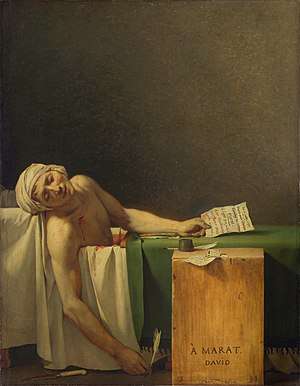
On 9 July 1793, Corday left her cousin, carrying a copy of Plutarch's Parallel Lives, and went to Paris, where she took a room at the Hôtel de Providence.[9] She bought a kitchen knife with a 6-inch (15 cm) blade. During the next few days, she wrote her Addresse aux Français amis des lois et de la paix ("Address to the French people friends of Law and Peace") to explain her motives for assassinating Marat.[10]
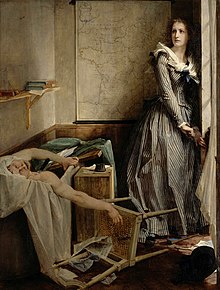
Corday initially planned to assassinate Marat in front of the entire National Convention. She intended to make an example of him, but upon arriving in Paris she discovered that Marat no longer attended meetings because his health was deteriorating due to a skin disorder (perhaps dermatitis herpetiformis). She was then forced to change her plan. She went to Marat's home before noon on 13 July, claiming to have knowledge of a planned Girondist uprising in Caen; she was turned away by Catherine Evrard, the sister of Marat's fiancée Simonne.[11]
On her return that evening, Marat admitted her. At the time, he conducted most of his affairs from a bathtub because of his skin condition. Marat wrote down the names of the Girondins that she gave to him; she then pulled out the knife and plunged it into his chest. He called out: Aidez-moi, ma chère amie! ("Help me, my dear friend!"), and then died.[12]
This is the moment memorialized by Jacques-Louis David's painting The Death of Marat. A different angle of the iconic pose of Marat dead in his bath is in Paul-Jacques-Aimé Baudry's 1860 painting Charlotte Corday.
In response to Marat's dying shout, Simonne Evrard rushed into the room. She was joined by a distributor of Marat's newspaper, who seized Corday. Two neighbors, a military surgeon and a dentist, attempted to revive Marat. Republican officials arrived to interrogate Corday and to calm a hysterical crowd who appeared ready to lynch her.[13]
Trial
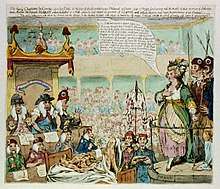
Charlotte Corday sent the following farewell letter to her father which was intercepted and read during the trial, the letter helping to establish that Marat's murder was premeditated:
Forgive me, my dear papa, for having disposed of my existence without your permission. I have avenged many innocent victims, I have prevented many other disasters. The people, one day disillusioned, will rejoice in being delivered from a tyrant. If I tried to persuade you that I was passing through England, it was because I hoped to keep it incognito, but I recognized the impossibility. I hope you will not be tormented. In any case, I believe that you would have defenders in Caen. I took Gustave Doulcet as a defender: such an attack allows no defense, it's for the form. Goodbye, my dear papa, please forget me, or rather rejoice in my fate, the cause is good. I kiss my sister whom I love with all my heart, as well as all my parents. Do not forget this verse by Corneille: Crime is shame, not the scaffold! It is tomorrow at eight o'clock that I am judged. This July 16.[14]
Corday underwent three separate cross-examinations by senior revolutionary judicial officials, including the President of the Revolutionary Tribunal and the chief prosecutor. She stressed that she was a republican and had been so even before the Revolution, citing the values of ancient Rome as an ideal model.[15]
The focus of the questioning was to establish whether she had been part of a wider Girondist conspiracy. Corday remained constant in insisting that "I alone conceived the plan and executed it." She referred to Marat as a "hoarder" and a "monster" who was respected only in Paris. She credited her fatal knifing of Marat with one blow not to practicing in advance but to luck.[16]
Charlotte Corday asked for Gustave le Doulcet, an old acquaintance, to defend her, but he did not receive the letter she wrote to him in time, so Claude François Chauveau-Lagarde was appointed instead to assist her during the trial.[17][18] It is believed that Antoine Quentin Fouquier-Tinville voluntarily delayed the letter,[1] however, it is said that Corday thought that Le Doulcet refused to defend her and sent to him a last letter of reproach just before going to the scaffold. [19]
Execution
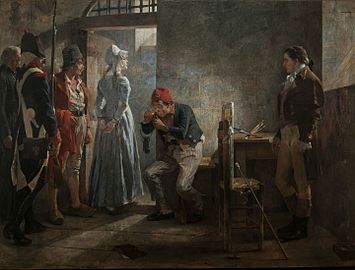
Following her sentencing Corday asked the court if her portrait could be painted, purportedly to record her true self.[20] She made her request pleading, "Since I still have a few moments to live, might I hope, citizens, that you will allow me to have myself painted."[21] Given permission, she selected as the artist a National Guard officer, Jean-Jacques Hauer, who had already begun sketching her from the gallery of the courtroom. Hauer's likeness (see above) was completed shortly before Corday was summoned to the tumbril, after she had viewed it and suggested a few changes.[22]
On 17 July 1793, four days after Marat was killed, Corday was executed by the guillotine in the Place de Grève wearing the red overblouse denoting a condemned traitor who had assassinated a representative of the people. Standing alone in the tumbril amid a large and curious crowd she remained calm, although drenched by a sudden summer rainfall.[23] Her body was buried in the Madeleine Cemetery.
Aftermath
After Corday's decapitation, a man named Legros lifted her head from the basket and slapped it on the cheek. Charles-Henri Sanson, the executioner, indignantly rejected published reports that Legros was one of his assistants. Sanson stated in his diary that Legros was in fact a carpenter who had been hired to make repairs to the guillotine.[24] Witnesses report an expression of "unequivocal indignation" on her face when her cheek was slapped. The oft-repeated anecdote has served to suggest that victims of the guillotine may in fact retain consciousness for a short while, including by Albert Camus in his Reflections on the Guillotine. ("Charlotte Corday's severed head blushed, it is said, under the executioner's slap.").[25]
This offense against a woman executed moments before was considered unacceptable and Legros was imprisoned for three months because of his outburst.[26]
Jacobin leaders had her body autopsied immediately after her death to see if she was a virgin. They believed there was a man sharing her bed and the assassination plans. To their dismay, she was found to be a virgin.[27]
The direct consequence of her crime were opposite to what she expected: the assassination did not stop the Jacobins or the Terror, which intensified after the murder.[1] Also Marat became a martyr, a bust of him replaced a religious statue on the rue aux Ours and a number of place-names were changed to honor Marat.[28]
Corday's act transformed the idea of what a woman was capable of, and to those who did not shun her for her act, she was a heroine. André Chénier, for example, wrote a poem in honor of Corday. This highlighted the "masculinity" possessed by Corday during the revolution.
| French (Original) | English (Translation) |
|---|---|
| La vertu seule est libre. Honneur de notre histoire,
Notre immortel opprobre y vit avec ta gloire, Seule tu fus un homme, et vengeas les humains. Et nous, eunuques vils, troupeau lâche sans âme, Nous savons répéter quelques plaintes de femme, Mais le fer pèserait a nos dèbiles mains. |
Virtue alone is free. Honor of our history,
Our immortal opprobrium lives there with your glory, Only you were a man, and avenged the humans. And we, vile eunuchs, a cowardly herd without a soul, We know how to repeat a few complaints from a woman, But the iron would be heavy in our feeble hands. |
The Revolution and women
Corday's killing of Marat was considered vile, an "arch-typically masculine statement", which reaction showed that whether or not one approved of what she did, it is clear that the murder of Marat changed the political role and position of women during the French Revolution.[29] Corday was surprised by the reaction of revolutionary women, stating, "As I was truly calm I suffered from the shouts of a few women. But to save your country means not noticing what it costs."[30]
After Corday murdered Marat, the majority of women distanced themselves from her because they believed that what she had done would spark a reaction against the now developing feminist movement, which was already facing criticism. Also, many of these women were attached to Marat in that they were supporters of his revolutionary efforts and sympathized with him as citizens of France.[21]
Cultural references
- American dramatist Sarah Pogson Smith memorialised Corday in her 1807 verse drama The Female Enthusiast: A Tragedy in Five Acts.[31]
- Percy Bysshe Shelley wrote about her in his Posthumous Fragments of Margaret Nicholson (1810).[32]
- Alphonse de Lamartine devoted to her a book of his Histoire des Girondins series (1847), in which he gave her this now-famous nickname: "l'ange de l'assassinat" (the angel of assassination).[33]
- French dramatist François Ponsard wrote a play, Charlotte Corday, that was premièred at the Théâtre-Français in March 1850.[34]
- In the 1862 novel Les Miserables, Combeferre likens Enjolras's execution of Le Cabuc to Corday's assassination of Marat, calling it a "liberating murder".[35]
- Harper's Weekly mentioned Corday in their 29 April 1865 edition, in a series of articles analyzing the assassination of Abraham Lincoln, as the "one assassin whom history mentions with toleration and even applause", but goes on to conclude that her assassination of Marat was a mistake in that she became Marat's victim rather than saving or helping his victims.[36]
- At the end of Act III, before departing to kill the Czar, the eponymous heroine of Oscar Wilde's play Vera; or, The Nihilists (1880) exclaims "the spirit of Charlotte Corday has entered my soul now".[37]
- In 1894, Kyrle Bellew penned a play in four acts detailing the assassination entitled Charlotte Corday, taking the role of Marat, while his acting partner Cora Urquhart Brown-Potter played as Charlotte Corday.[38]
- In the 1903 novel Rebecca of Sunnybrook Farm, young Rebecca re-enacts a scene of Charlotte Corday in prison, with her friends playing the role of the mob.[39]
- The 1919 German silent film Charlotte Corday starred Lya Mara in the title role.
- Drieu La Rochelle wrote a play in three acts called Charlotte Corday in 1939. It was performed in southern France during World War II. Corday is depicted as a fervent republican who hopes eliminating Marat will save the revolution and prevent it from degenerating into tyranny.[40]
- In Peter Weiss's 1963 Marat/Sade, the assassination of Marat is presented as a play, written by the Marquis de Sade, to be performed for the public by inmates of the asylum at Charenton.
- Italian composer Lorenzo Ferrero composed an opera in three acts, Charlotte Corday, for the 200th anniversary of the French Revolution which was commemorated in 1989.
- Corday is a character in Katherine Neville's 1988 novel The Eight. In the novel, Marat is killed, not by Corday, but by a former nun named Mireille. Corday accepts the blame and is executed for the crime so that Mireille may continue her quest for the mysterious and powerful Montglane Chess Service.
- Actor Herbert Lom's 1993 novel Dr Guillotine features Corday as a principal protagonist in a story set around the Reign of Terror.[41]
- British singer-songwriter Al Stewart included a song co-written by Tori Amos about Corday on his album Famous Last Words (1993).[42]
- Charlotte appears briefly but significantly, in Caen, in A Far Better Rest (2010), by Susanne Alleyn, a reimagining of A Tale of Two Cities.[43]
- The graphic novel series L'Ordre Du Chaos includes a whole book dedicated to Charlotte Corday and Marat (2014).[44]
- Corday is a central character in Lauren Gunderson's 2017 play The Revolutionists, a comedic quartet about four French women during the Reign of Terror.[45]
- Corday appears in the mobile videogame Fate/Grand Order as a playable servant of the "Assassin" class to be summoned by the player.
Gallery
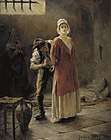 Painting of Charlotte Corday by Julian Story (1889)
Painting of Charlotte Corday by Julian Story (1889)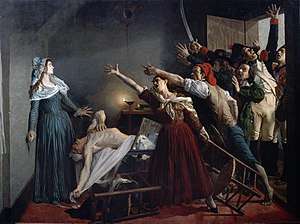 The Assassination of Marat by Jean-Joseph Weerts (1880)
The Assassination of Marat by Jean-Joseph Weerts (1880) The Death of Marat by Guillaume-Joseph Roques (1793); a knife lies on the floor at lower left in the paintings by Roques and David
The Death of Marat by Guillaume-Joseph Roques (1793); a knife lies on the floor at lower left in the paintings by Roques and David Detail from The Death of Marat by Jacques-Louis David, Royal Museums of Fine Arts of Belgium
Detail from The Death of Marat by Jacques-Louis David, Royal Museums of Fine Arts of Belgium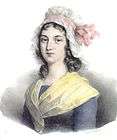 Charlotte Corday by François-Séraphin Delpech
Charlotte Corday by François-Séraphin Delpech
References
- "Le procès de Charlotte Corday". French Ministry of Justice. 23 August 2011. Retrieved 5 August 2018.
- "Charlotte Corday", Encyclopedie (in French), FR: Larousse, archived from the original on 21 July 2011, retrieved 8 June 2010
- Whitham, John Mills (1968), Men and Women of the French Revolution, Freeport, NY: Books for Libraries Press
- Cabanès, Augustin (1898). Curious Bypaths of History: Being Medico-historical Studies and Observations. C. Carrington. p. 352.
charlotte corday passport.
- Cher, Marie (1929). Charlotte Corday and Certain Men of the Revolutionary Torment. New York: D. Appleton and Company. p. 70. ISBN 1-4366-8354-8.
- Andress, David (2005). The Terror. Great Britain: Farrar, Straus and Giroux. ISBN 978-0-374-53073-0.
- Elizabeth, Kindleberger (1994). Charlotte Corday in Text and Image: A Case Study in the French Revolution and Women's History. Duke University Press. p. 973.
- Schama 2005, p. 445.
- The Hotel was at 19 rue des Vieux Augustins, now rue d'Argout
- Cobb, Richard (1988) The French Revolution. Voices From A Momentous Epoch. Guild Publishing. pg. 192; ISBN 978-0671699253
- Schama 2005, p. 735.
- Schama 2005, p. 736.
- Schama 2005, p. 737.
- Pardonnez-moi, mon cher papa, d’avoir disposé de mon existence sans votre permission. J’ai vengé bien d’innocentes victimes, j’ai prévenu bien d’autres désastres. Le peuple, un jour désabusé, se réjouira d’être délivré d’un tyran. Si j’ai cherché à vous persuader que je passais en Angleterre, c’est que j’espérais garder l’incognito, mais j’en ai reconnu l’impossibilité. J’espère que vous ne serez point tourmenté. En tout cas, je crois que vous auriez des défenseurs à Caen. J’ai pris pour défenseur Gustave Doulcet : un tel attentat ne permet nulle défense, c’est pour la forme. Adieu, mon cher papa, je vous prie de m’oublier, ou plutôt de vous réjouir de mon sort, la cause en est belle. J’embrasse ma sœur que j’aime de tout mon cœur, ainsi que tous mes parents. N’oubliez pas ce vers de Corneille:
Le Crime fait la honte, et non-pas l’échafaud !
C’est demain à huit heures, qu’on me juge. Ce 16 juillet. - Cobb, Richard (1988). The French Revolution. Voices from a momentous epoch: 1789–1795, Guild Publishing. pp. 192–93. ISBN 978-0671699253
- Schama 2005, pp. 736–37.
- "13 juillet 1793 : Charlotte Corday assassine le citoyen Marat dans sa baignoire". Le Figaro. 12 July 2018. Retrieved 6 August 2018.
- Du Bois, Louis (1838). Charlotte de Corday : essai historique, offrant enfin des détails authentiques sur la personne et l'attentat de cette héroïne. Librairie Historique de la Révolution. p. 141.
Charlotte Corday + lagarde.
- . Encyclopædia Britannica. 22 (11th ed.). 1911.
- Chantal, Thomas (1789). HEROISM IN THE FEMININE: THE EXAMPLES OF CHARLOTTE CORDAY AND MADAME ROLAND. University of Pennsylvania Press.
- Thomas, Chantal (1989). HEROISM IN THE FEMININE: THE EXAMPLES OF CHARLOTTE CORDAY AND MADAME ROLAND. University of Pennsylvania Press.
- Schama 2005, pp. 740–741.
- Schama 2005, p. 741.
- La Révolution française vue par son bourreau : Journal de Charles-Henri Sanson, Documents (in French), Monique Lebailly, preface, Le Cherche Midi, 2007, p. 65, ISBN 978-2-7491-0930-5CS1 maint: others (link); idem, Griffures, Paris: Éditions de l'Instant, 1988, ISBN 978-2-86929-128-7
- Koestler, Arthur and Camus, Albert (2002) Reflexions sur la peine Capitale. Calmann-Levy, p. 139. ISBN 978-2070418466
- Mignet, François (1824), History of the French Revolution from 1789 to 1814
- Corazzo, Nina; Montfort, Catherine R (1994), "Charlotte Corday: femme-homme", in Montfort, Catherine R (ed.), Literate Women and the French Revolution of 1789, Birmingham, AL: Summa Publications, p. 45
- Schama 2005, p. 745.
- Kindleberger, Elizabeth (1994). Charlotte Corday in Text and Image: A Case Study in the French Revolution and Women's History. Duke University Press. pp. 969–999.
- Revue contemporaine. 79. 1865. p. 618.
- Harris, Sharon M., ed. (24 June 2003). Women's Early American Historical Narratives. Penguin Publishing Group. p. 136. ISBN 978-1440626593. Retrieved 11 July 2018.
- Shelley, Percy Bysshe; Hogg, Thomas Jefferson (1810). Posthumous fragments of Margaret Nicholson; being poems found amongst the papers of that noted female who attempted the life of the king in 1786. Oxford, UK: J. Munday. pp. 11–17.
- de Lamartine, Alphonse (1995). Histoire de Charlotte Corday: un livre de l'Histoire des Girondins [History of Charlotte Corday: A book of the History of the Girondins] (in French). Editions Champ Vallon. p. 13. ISBN 978-2876732025. Retrieved 11 July 2018.
- Ponsard, François (1867). Cassal, C. (ed.). Charlotte Corday: A Tragedy. Trübner and Company. p. 7. Retrieved 11 July 2018.
- Hugo, Victor (1987). Les Miserables. Translated by Lee Fahnestock & Norman MacAfee. Signet Classics. p. 1175. ISBN 978-0-451-41943-9.
- Harper's Weekly: Volume 9 for the Year 1865. Harper's Magazine Company. 1865. p. 278.
- Wilde, Oscar (1907). The Writings of Oscar Wilde: Salome; The duchess of Padua; Vera, or, The nihilists. Keller-Farmer. p. 400. Retrieved 11 July 2018.
- Bellew, Kyrle (1912). Short Stories. the Shakespeare Press. p. 138. Retrieved 3 March 2019.
- Wiggins, Kate Douglas (1903). Rebecca of Sunnybrook Farm (Golden Illustrated ed.). p. 62.
- "Charlotte Corday (1942)" (PDF). Archives Drieu La Rochelle (in French). Retrieved 11 July 2018.
- Lom, Herbert (1993). Dr Guillotine: The Eccentric Exploits of an Early Scientist. Trafalgar Square. ISBN 978-1856191111.
- Charlotte Corday at AllMusic
- Eckford, Teresa (August 2000). "A Far Better Rest by Susanne Alleyn". Historical Novels Review. Retrieved 11 July 2018.
- Perez, Damien; Ricaume, Sophie; Alexander, Alexis (2014), L'Ordre Du Chaos (in French), IV. Charlotte Corday, Delcourt, ISBN 978-2756024820
- "The Revolutionists". New Play Exchange. Retrieved 11 July 2018.
Attribution

Further reading
- Alstine, RK van (2008), Charlotte Corday, Kellock Robertson Press, ISBN 978-1-4097-9658-9.
- Corazzo, Nina, and Catherine R. Montfort (1994), "Charlotte Corday: femme-homme", in Montfort, Catherine R (ed.), Literate Women and the French Revolution of 1789, Birmingham, AL: Umma Publications.
- Corday, Charlotte, L'Addresse aux Français amis des lois et de la paix [Address to French friends of the Law and Peace], archived from the original on 5 August 2018, retrieved 5 August 2018.
- Franklin, Charles (1967), Woman in the Case, New York: Taplinger.
- Margaret L. Goldsmith (1935), Seven Women Against the World, London: Methuen.
- Gutwirth, Madelyn (1992), The Twilight of the Goddesses; Women and Representation in the French Revolutionary Era, New Brunswick, NJ: Rutgers University Press.
- Kindleberger, Elizabeth R (1994), "Charlotte Corday in Text and Image: A Case Study in the French Revolution and Women's History", French Historical Studies, 18, pp. 969–99.
- Stanley Loomis (1964), Paris in the Terror, JB Lippincott.
- Mazeau, Guillaume (2009), Le bain de l'histoire. Charlotte Corday et l'attentat contre Marat (1793–2009), Champ Vallon: Seyssel.
- ———— (2009), Corday contre Marat. Deux siècles d'images, Versailles: Artlys.
- ———— (2006), Charlotte Corday en 30 Questions, La Crèche, Geste éditions.
- Outram, Dorinda (1989), The Body and the French Revolution: Sex, Class and Political Culture, New Haven: Yale University Press.
- Simon Schama; John Livesey (2005), Citizens: A Chronicle of the French Revolution, London: Royal National Institute of the Blind, ISBN 0-670-81012-6
- Sokolnikova, Halina (1932), Nine Women Drawn from the Epoch of the French Revolution, trans. H C Stevens, Cape, NY.
- Whitham, John Mills (1968), Men and Women of the French Revolution, Freeport, NY: Books for Libraries Press.
External links
![]()
- Images of Charlotte Corday and of places related to her life, Vimoutiers.
- Charlotte Corday (video), News, France 3.